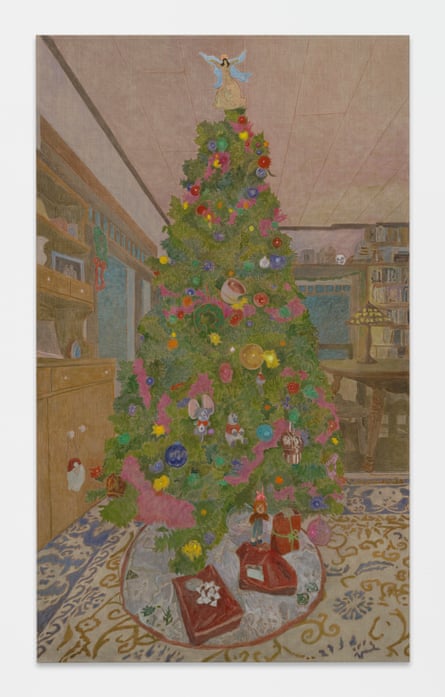Time is a return ticket in Ibrahim Mahama’s Songs About Roses, which is on display at the Fruitmarket Gallery, far and away the best show in this year’s Edinburgh art festival. Mahama draws young men lugging rails in detailed yet suggestively poetic charcoal, but are they laying tracks for the British empire’s Gold Coast railway – or removing them?
My attention was grabbed the moment I stuck my head through the gallery door. For this Ghanaian artist has produced a show as extraordinary as a great magic-realist novel on a theme such a novel might address: the rise and fall of the railway the British government built between 1898 and 1923 in its Gold Coast colony. It would win independence and become Ghana in 1957.

Defenders of the British empire’s legacy often point to railways as a positive achievement – but this one was built to move minerals and tropical wood for British profit, not for Africa. Mahama’s archaeology of this industrial behemoth shows in detail how companies back home in Britain profited. As well as his powerful drawings, in which African people struggle under the railway’s physical demands, there are painted replicas of Manchester engineering firms’ trademarks, films of decaying industrial spaces, graffiti painted on bark and photos of a performance-art reenactment of a rail being carried. The atmosphere he creates, of decay and futility, of a doomed colonial fantasy turned to rust, reaches its climax in the Fruitmarket’s Warehouse space, where you can still smell the engine oil in a loft reclaimed from an abandoned part of the city’s Waverley Station.
Here Mahama has built structures out of railway sleepers to display lifesized cutout portraits of former Gold Coast railway employees, drawn from formal group photographs. He has taken the little monochrome faces in stiffly posed pictures and made them live again as individuals. This reckoning with history’s ghosts puts Mahama up there with William Kentridge and Anselm Kiefer as one of today’s most important artists.
He also, nearly, makes sense of this art festival’s mission statement. For its 20th anniversary, it is “looking to artists, structures and figures who push back, and refuse”. I found it harder to see this matched elsewhere. Certainly not in a portrait of Winston Churchill at his easel in the south of France, one of the gentle paintings by the Belfast-born Sir John Lavery getting a sunny retrospective at the Royal Scottish Academy. I suppose Churchill, colonial secretary when Lavery depicted him, so actually responsible for the Gold Coast railway, resisted the end of empire. Lavery’s brushy, moist paintings of river scenes and the seaside are joyous by the standards of Victorian and Edwardian art, but I found the show slightly soporific, like a day at the beach with grandparents. He is certainly not an “Irish impressionist” as the show hyperbolically claims.

Lavery takes you into a lost historical world, and as I walked between the Old and New Towns trying to connect up the festival’s exhibitions, that sense of being lost in time recurred. Cold War Scotland at the National Museum is a display of relics from the 1950s to 1980s including steel blast doors from a bunker in East Kilbride. Stained by time and vandalism, they look like a Kieferesque artwork.
after newsletter promotion

There’s an inevitable irony to looking at old Protect and Survive brochures and a suit that was supposed to protect soldiers from radiation. Imagine – they actually thought the USSR was going to start a war! Then you visit the Stills Gallery and are confronted with the present – no irony, no distance, just raw photographs from Ukraine that show what a Russian invasion feels like, and how much life can be – is being – torn apart with conventional weapons.
Nazar Furyk’s pictures of the city of Kherson, after it was partly liberated, explore landscapes of ruin: a destroyed bridge in the mist, a scorched field, a forgotten football. The most devastating photograph is not for the fainthearted. Mykhaylo Palinchak shows civilians lying dead on a road in Bucha in the Kyiv region in 2022. They lie together on their backs, arms spread out, thick dark blood spreading around them. Were they executed?
No wonder, when this is reality, that we long to escape. Rather than “resistance”, a lot of the art offers full-on pastoral pleasure. Los Angeles painter Hayley Barker has a show at the Ingleby Gallery in the New Town, whose light-filled central space suits her delicate paintings of gardens: purple cacti, a path, a yellow moon through the bushes. If these paintings seem at first too pretty, their colours become weirder as you look, subtly hooking the pleasure principle of the optic nerve, unleashing unknown endorphins.
At Dovecot Studios in the Old Town, that enigmatic neural science of colour is shown to apply not just to paint, but wool. This is a special Scottish place: a living craft workshop founded by followers of William Morris where weavers work with leading artists to create tapestries. I got a tour of the workshop and the weavers didn’t look up once from their looms.
Dovecot’s festival show might seem self-congratulatory: a “making of” exhibition that tells the tale of how they worked with Chris Ofili on his tapestry The Caged Bird’s Song. Detailed and finely lit displays reveal how the weavers experimented with multicoloured interwoven threads to transfer Ofili’s subtle palette into fabric. Then you finally see the tapestry, and it takes you into a dream world of Trinidadian folklore and landscape, at once comical and erotic. I found it hard to leave. Ofili is beautifully celebrated here as the Matisse of Trinidad.
Resistance? More like bliss.

Comments (…)
Sign in or create your Guardian account to join the discussion